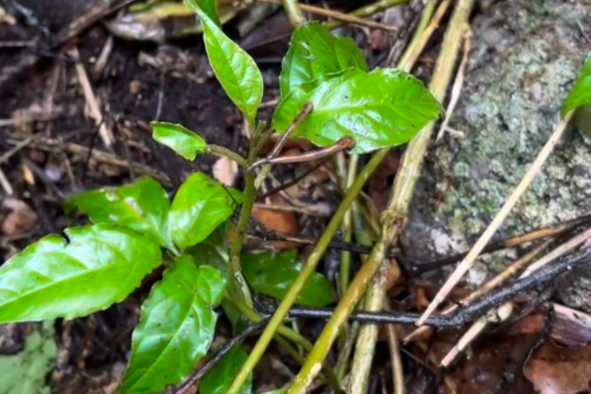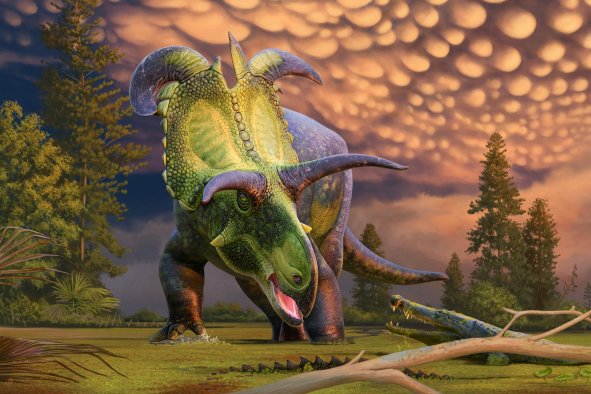Researchers have discovered a previously unknown crocodile-like reptile species that lived around 237 million years ago during the Triassic Period. It has been described as an "extremely rare" discovery.
The remains of the predatory prehistoric reptile, dubbed Parvosuchus aurelioi, were found in a fossil-rich site named "Linha Várzea 2"—located in the municipality of Paraíso do Sul, southern Brazil—by amateur paleontologist Pedro Lucas Porcela Aurélio.
Aurélio discovered the partial skeleton of a specimen, including a complete skull, 11 vertebrae and partially preserved limbs.
After Aurélio's discovery, the remains were donated to the Paleontology Research Center at the Federal University of Santa Maria (UFSM) in Brazil, where paleontologist Rodrigo Müller prepared and examined the specimen.
These investigations resulted in the description of the new species, which has been detailed in a study published in the Nature journal Scientific Reports.
"The remains were covered by a thick layer of rock. At first glance, only some portions of the vertebrae were visible. I started the preparation process with the aid of acid solutions and pneumatic hammers. During this step, parts of the cranium appeared from the rock, revealing a complete skull," Müller told Newsweek.
"The moment when I realized that the skull was embedded in the rock was stunning. As I slowly removed a layer of rock, part of the orbital rim was exposed. It was as if this animal was looking at me—as if it had been waiting all these endless years to tell its story," he said.
The newly described species belongs to a group of animals known as the pseudosuchians, which are reptiles more related to crocodilians than to other modern reptiles. Living pseudosuchians are restricted to alligators, crocodiles and gharials. But in the past, this group of reptiles was far more diverse.
Pseudosuchians form part of the wider group that also includes dinosaurs—known as the archosaurs, but they are not closely related to dinosaurs. Despite this, they did live side by side with dinosaurs for long periods.
Pseudosuchians achieved evolutionary success before the origin of dinosaurs. But they suffered a loss of diversity when dinosaurs emerged (roughly 230-240 million years ago), according to Müller.
Prior to the dominance of dinosaurs, pseudosuchians were a common form of reptile during the Triassic Period (201-252 million years ago), with some species ranking among the largest carnivores of the time.
But other smaller pseudosuchians, known as gracilisuchids, also lived alongside these apex predators. According to the study, the Parvosuchus aurelioi is a species of gracilisuchid and represents the first unequivocal member of this group to be discovered in Brazil.
Gracilisuchids are "extremely rare" in the fossil record, making the latest discovery significant, Müller said. Only three gracilisuchid species were known previously: two from China and one from Argentina. Even more notable is the fact that P. aurelioi is the first species of this group to be described in more than two decades.
The skull of the new species measures around 5 inches length and features long, slender jaws with pointed teeth that curved backwards. The skeleton is lightly built and Müller estimates that the animal measured around 6.5 feet in length when it was alive—including a long tail—while standing about 0.8 feet tall at the hip.
"It stood on four legs that are adapted to walk on land," Müller said. "Regarding [its] diet, Parvosuchus aurelioi had blade-like teeth, which are adapted to tear flesh. Moreover, it had a lightly built skeleton, indicating that it was an agile hunter."
Despite its hunting prowess, the species lived in environments dominated by much larger predators
"We can imagine that Parvosuchus aurelioi had to be a stealthy animal to hunt his prey, while also needing to avoid predators larger than itself," Müller said.
Parvosuchus aurelioi also shared environments with large herbivorous creatures called dicynodonts, which are distantly related to mammals. These large herbivores were hunted by huge prehistoric reptiles, such as Prestosuchus chiniquensis, which reached approximately 23 feet in length.
The name of the new species derives from the Latin words "parvus" (meaning "small") and "suchus" (meaning "crocodile"), while also honoring the amateur paleontologist first discovered the fossil remains.
The latest discovery highlights the diversity among pseudosuchians in the Triassic period, shedding light on the prehistoric ecosystems of Earth prior to the dominance of dinosaurs.
Do you have an animal or nature story to share with Newsweek? Do you have a question about paleontology? Let us know via science@newsweek.com.
Disclaimer: The copyright of this article belongs to the original author. Reposting this article is solely for the purpose of information dissemination and does not constitute any investment advice. If there is any infringement, please contact us immediately. We will make corrections or deletions as necessary. Thank you.



